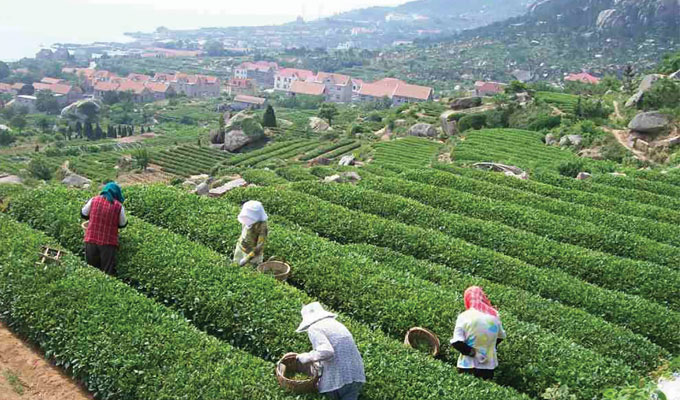Let me tell you about this green tea I’m drinking. Laoshan tea (崂山茶), from Qingdao. It’s all a bit of a mystery. But, as these leaves unravel (slowly), I’m building up more of a picture.
Let’s be honest; Baidu is helping out as well.
This tea was a gift from a friend, who, like the tea, hails from Shandong,that peninsula jutting out from the east of China. It’s not North China. But Shandong is distinctly “northern” in tea terms; further north than Henan, home of the previous, most-northerly tea plantation mentioned in Strainer, Xinyang Magian (信阳毛尖).
Tea growing benefits from southern climes (that’s why it doesn’t grow in Wales), and tea also benefits from altitude, which normally depends on central location within a large landmass; the world’s tallest mountains do not overlook the sea.
- Sugar-Free Bottled Tea; China’s Wu Tang Clan
- Which Tea Brand Best Compliments Your Private Jet?
- Long Time, Long Jing No See
Yet, Shandong is a coastal province, and the Laoshan mountain range, just east of Qingdao, clearly borders the sea. We’re used to thinking of tea fields looking down on lakes or even a “sea of clouds”. Perhaps this is the closest thing to a real “sea tea”.
Altitude is achieved, it seems; Baidu’s photographs suggest these fields overlook the sea from a great height. It’s a rocky landscape, but also a very green one. I see the pictures of the production facilities – those earnest blue roofs of industry.
Drinking this tea, I am aware of two distinct phases. There’s a very biscuity first cup. This biscuity, sweet pea quality is apparent from the smell of the dried leaves. Now, sometimes, I can retain this quality by feeding the leaves progressively cooler water with each steeping. But that’s not working here.
There’s an astringency that defines the experience of drinking this tea. It overrides the sweet sensations from the second steeping onwards, and that’s a slight disappointment to this drinker.
- Apocalypse Tea; Should I Drive After Drinking This?
- Perfect Median; China’s Take on Earl Grey
- Swallowing is Just the Beginning; Rain, Flower, Cloud!
The leaves actually remain tangled for a long time; unlike, say, lu’an guapian (六安瓜片), another green tea with a “biscuity” opening. But it doesn’t feel to me that these dark green leaves are coyly concealing their charms; there’s little incentive to persevere with them ad infinitum. Actually, for today’s drinking, I have chosen to replace the leaves with new ones, rather than just adding water.
Maybe I will grow to love this green tea while finishing the bag in the freezer. But for now I’m more intrigued by its provenance and miniature-oolong-like appearance than blown away by its flavour.
It’s not a famous tea in China. Perhaps, like our local yuhua cha (雨花茶), the smallness of the planting region makes it difficult to achieve economies of scale or to reach that tipping point in the public consciousness. Shandong province does produce a more famous green tea, rizhao cha (sunshine tea; 日照茶). That’s a topic for a future Strainer.
Sorry to say, Laoshan tea doesn’t taste of sea salt or sea weed. Nothing like it. But, if you hold your ear close to the teacup, you can hear the sea!











